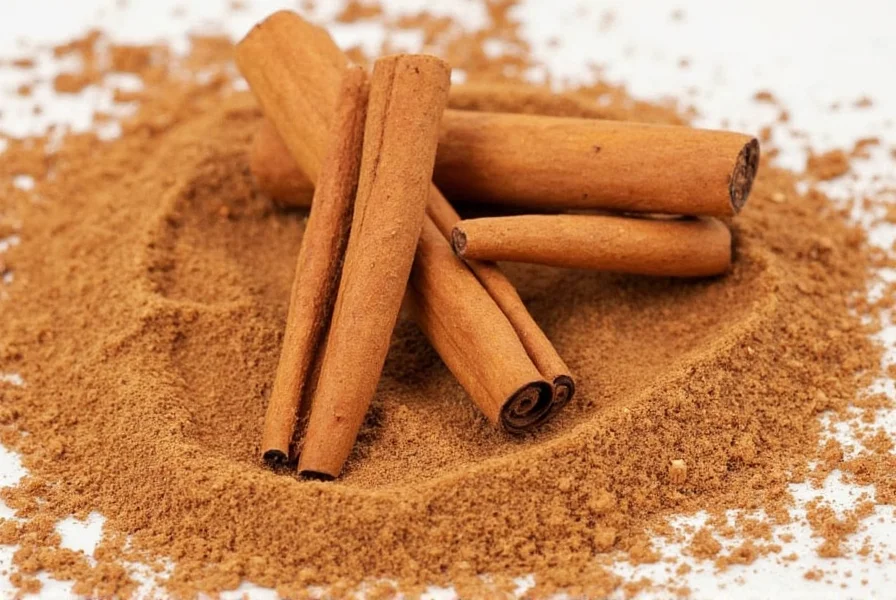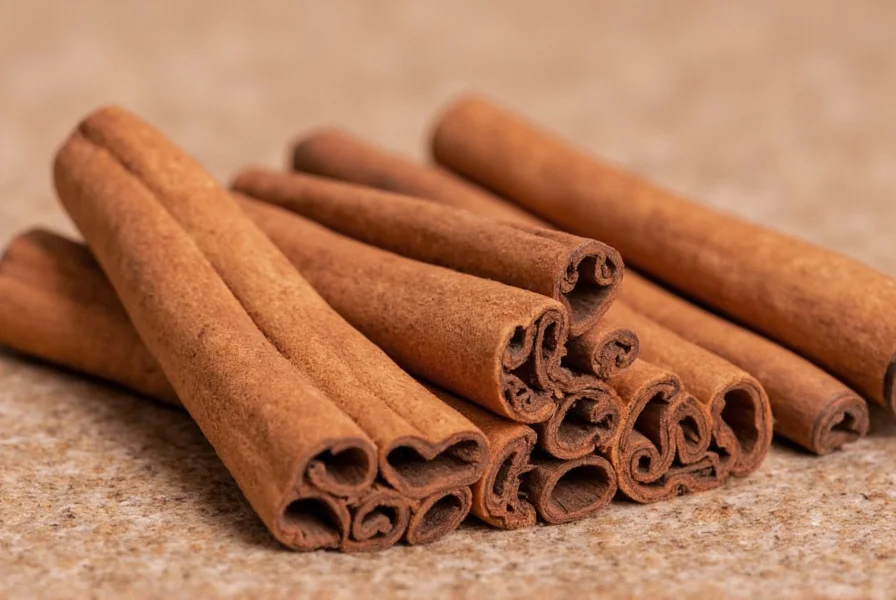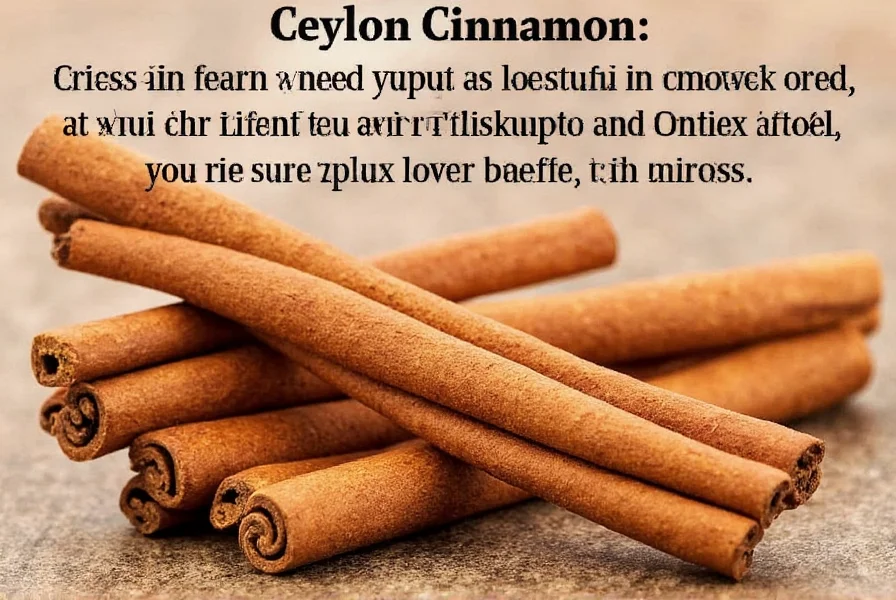When shopping for cinnamon, understanding the critical differences between true Ceylon cinnamon and its Cassia counterpart is essential for both health and flavor purposes. This comprehensive guide explores the botanical distinctions, health implications, identification methods, and proper usage of authentic Ceylon cinnamon—the variety historically traded as "true" cinnamon.
What Makes Ceylon Cinnamon "True" Ceylon?
The term "true Ceylon cinnamon" refers specifically to Cinnamomum verum (formerly Cinnamomum zeylanicum), native to Sri Lanka (formerly Ceylon). This species represents the original cinnamon known to ancient civilizations and European traders. Unlike the more widely available Cassia varieties (primarily Cinnamomum cassia from China and Cinnamomum loureiroi from Vietnam), Ceylon cinnamon features multiple delicate bark layers that form a tight, hollow tube when dried—a characteristic known as a "quill."
Historically, Ceylon cinnamon commanded premium prices during colonial trade eras, with Portuguese, Dutch, and British powers controlling its production. Today, Sri Lanka still produces approximately 80-90% of the world's genuine Ceylon cinnamon, maintaining traditional harvesting methods that involve carefully peeling the inner bark of two-year-old shoots.
Ceylon vs. Cassia: Critical Differences You Should Know
Understanding the distinction between true Ceylon cinnamon and Cassia varieties is crucial for both culinary applications and health considerations. Most cinnamon sold in supermarkets—particularly in the United States—is actually Cassia, often mislabeled simply as "cinnamon."
| Characteristic | True Ceylon Cinnamon | Cassia Cinnamon |
|---|---|---|
| Scientific Name | Cinnamomum verum | Cinnamomum cassia |
| Origin | Sri Lanka | China, Indonesia, Vietnam |
| Bark Structure | Multiple thin layers forming delicate quills | Single thick, hard layer |
| Color | Light tan to pale brown | Dark reddish-brown |
| Taste Profile | Subtle, sweet, citrusy notes | Strong, spicy, sometimes bitter |
| Coumarin Content | Approximately 0.017g/kg | Approximately 6.97g/kg (400x higher) |
| Price | Higher (typically 5-10x Cassia) | Lower |
Health Implications: Why the Ceylon Cinnamon Coumarin Difference Matters
The most significant health consideration when choosing between Ceylon and Cassia cinnamon involves coumarin content. Coumarin, a naturally occurring compound, can cause liver damage when consumed in excessive amounts over time. The European Food Safety Authority established a tolerable daily intake of 0.1mg coumarin per kilogram of body weight.
Research published in Food and Chemical Toxicology demonstrates that just one teaspoon of Cassia cinnamon may contain up to 12.1mg of coumarin—exceeding the acceptable daily limit for most adults. In contrast, the same quantity of Ceylon cinnamon contains only trace amounts, making it the safer choice for regular consumption, particularly for children, individuals with liver conditions, or those using cinnamon therapeutically.
Studies suggest both varieties offer potential health benefits including blood sugar regulation, anti-inflammatory properties, and antioxidant effects. However, the significantly lower coumarin content in authentic Ceylon cinnamon makes it the preferred option for daily use when seeking these potential benefits.

How to Identify Authentic Ceylon Cinnamon
Spotting genuine Ceylon cinnamon requires attention to several physical characteristics:
- Structure: Look for multiple thin, papery layers that form a delicate, hollow tube (quill). Cassia typically has a single thick, hard layer that doesn't form a complete tube.
- Texture: Ceylon cinnamon feels brittle and crumbles easily when bent. Cassia remains rigid and difficult to break.
- Color: True Ceylon has a lighter tan to pale brown color, while Cassia appears darker with reddish undertones.
- Aroma: Ceylon offers a sweeter, more delicate fragrance with citrus notes, whereas Cassia has a stronger, spicier scent.
- Labeling: Check for "Cinnamomum verum," "Cinnamomum zeylanicum," or "True Ceylon Cinnamon" on packaging. Terms like "Mexican cinnamon" or "Chinese cinnamon" indicate Cassia varieties.
When purchasing ground cinnamon, identification becomes more challenging. Reputable specialty spice merchants who specify the cinnamon variety represent your best option for authentic Ceylon. Avoid products simply labeled "cinnamon" without botanical specification, as these typically contain Cassia.
Culinary Applications of True Ceylon Cinnamon
Chefs and food enthusiasts prefer Ceylon cinnamon for specific applications where its delicate flavor profile shines:
- Baking: Ideal for delicate pastries, custards, and light-colored desserts where its subtle flavor won't overpower other ingredients
- Beverages: Perfect for coffee, hot chocolate, and mulled wines where its citrus notes complement other flavors
- Seafood: Traditional in Mediterranean cuisine for enhancing fish and shellfish dishes
- Rice Pudding: Essential ingredient in authentic Sri Lankan and Portuguese rice puddings
- Spice Blends: Preferred in Middle Eastern and Indian spice mixes where balance is crucial
Because of its more delicate flavor, use Ceylon cinnamon in slightly larger quantities than Cassia when substituting in recipes. Its lower coumarin content also makes it suitable for daily use in health-focused applications like morning smoothies or oatmeal without safety concerns.
Storage Recommendations for Maximum Freshness
To preserve the volatile oils that give Ceylon cinnamon its distinctive flavor and potential health benefits, proper storage is essential:
- Store in an airtight container away from light and heat
- Whole quills retain freshness significantly longer than ground cinnamon (up to 2 years versus 6-12 months)
- Refrigeration can extend shelf life but requires careful moisture control
- Grind only what you need immediately before use for optimal flavor
Unlike Cassia, which maintains potency longer due to higher oil content, Ceylon cinnamon's delicate compounds degrade more quickly, making fresh, properly stored product essential for best results.

Addressing Common Misconceptions
Several myths persist about true Ceylon cinnamon that deserve clarification:
- "Ceylon cinnamon has no health benefits": Research shows both varieties contain beneficial compounds, but Ceylon's safety profile makes regular consumption feasible.
- "All cinnamon is the same": Botanically and chemically, Ceylon and Cassia are distinct species with different properties.
- "Ceylon cinnamon is just more expensive": The price difference reflects lower production volume, traditional harvesting methods, and genuine scarcity.
- "Coumarin concerns are exaggerated": Regulatory agencies worldwide have established limits based on documented liver toxicity cases.
Practical Guidance for Consumers
When incorporating cinnamon into your diet with health considerations in mind:
- For daily consumption (more than 1/2 teaspoon), choose verified Ceylon cinnamon
- Check product labels for botanical names rather than generic "cinnamon"
- Consider third-party testing certifications for authenticity verification
- Be wary of extremely low-priced "Ceylon" cinnamon, which may be mislabeled
- Consult healthcare providers before using cinnamon therapeutically, especially if taking medications
Understanding these distinctions empowers you to make informed choices that balance flavor preferences with health considerations—particularly important for those using cinnamon regularly for potential wellness benefits.
What's the main difference between true Ceylon cinnamon and regular cinnamon?
The primary difference is that "regular" cinnamon typically refers to Cassia varieties (Chinese, Vietnamese, or Indonesian cinnamon), while true Ceylon cinnamon (Cinnamomum verum) comes from Sri Lanka. Ceylon has multiple thin bark layers forming delicate quills, a lighter color, sweeter flavor, and contains approximately 90% less coumarin than Cassia varieties.
Why is coumarin content important when choosing cinnamon?
Coumarin is a naturally occurring compound that can cause liver damage when consumed in excessive amounts over time. Cassia cinnamon contains significantly higher levels (up to 400 times more) than Ceylon cinnamon. For regular consumption, especially for children or those with liver conditions, Ceylon's much lower coumarin content makes it the safer choice.
How can I verify I'm buying authentic Ceylon cinnamon?
Look for specific indicators: multiple thin, papery bark layers that form a delicate quill (not a single thick layer), light tan color, sweet citrusy aroma, and labeling that specifies "Cinnamomum verum," "Cinnamomum zeylanicum," or "True Ceylon Cinnamon." Purchase from reputable spice merchants who provide origin information and consider third-party testing certifications for authenticity verification.
Is Ceylon cinnamon worth the higher price?
For regular consumption, especially for health purposes, Ceylon cinnamon's significantly lower coumarin content makes it worth the premium price. If you use cinnamon daily in substantial amounts, the health advantages outweigh the cost difference. For occasional use in recipes where strong flavor is desired, Cassia may be sufficient, but for daily wellness applications, Ceylon represents a safer long-term choice.
Can I substitute Ceylon cinnamon for Cassia in recipes?
Yes, but you may need to adjust quantities. Ceylon cinnamon has a more delicate flavor, so you might use 25-50% more than Cassia to achieve similar flavor intensity. In baking, Ceylon works best in delicate recipes like custards and light-colored desserts, while Cassia performs better in robust recipes like gingerbread where its stronger flavor won't be overpowered.
Frequently Asked Questions
What's the main difference between true Ceylon cinnamon and regular cinnamon?
The primary difference is that "regular" cinnamon typically refers to Cassia varieties (Chinese, Vietnamese, or Indonesian cinnamon), while true Ceylon cinnamon (Cinnamomum verum) comes from Sri Lanka. Ceylon has multiple thin bark layers forming delicate quills, a lighter color, sweeter flavor, and contains approximately 90% less coumarin than Cassia varieties.
Why is coumarin content important when choosing cinnamon?
Coumarin is a naturally occurring compound that can cause liver damage when consumed in excessive amounts over time. Cassia cinnamon contains significantly higher levels (up to 400 times more) than Ceylon cinnamon. For regular consumption, especially for children or those with liver conditions, Ceylon's much lower coumarin content makes it the safer choice.
How can I verify I'm buying authentic Ceylon cinnamon?
Look for specific indicators: multiple thin, papery bark layers that form a delicate quill (not a single thick layer), light tan color, sweet citrusy aroma, and labeling that specifies "Cinnamomum verum," "Cinnamomum zeylanicum," or "True Ceylon Cinnamon." Purchase from reputable spice merchants who provide origin information and consider third-party testing certifications for authenticity verification.
Is Ceylon cinnamon worth the higher price?
For regular consumption, especially for health purposes, Ceylon cinnamon's significantly lower coumarin content makes it worth the premium price. If you use cinnamon daily in substantial amounts, the health advantages outweigh the cost difference. For occasional use in recipes where strong flavor is desired, Cassia may be sufficient, but for daily wellness applications, Ceylon represents a safer long-term choice.
Can I substitute Ceylon cinnamon for Cassia in recipes?
Yes, but you may need to adjust quantities. Ceylon cinnamon has a more delicate flavor, so you might use 25-50% more than Cassia to achieve similar flavor intensity. In baking, Ceylon works best in delicate recipes like custards and light-colored desserts, while Cassia performs better in robust recipes like gingerbread where its stronger flavor won't be overpowered.











 浙公网安备
33010002000092号
浙公网安备
33010002000092号 浙B2-20120091-4
浙B2-20120091-4